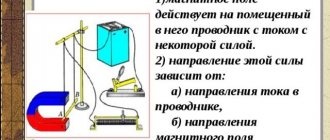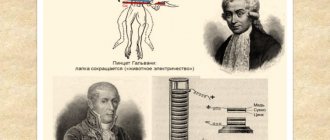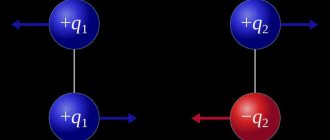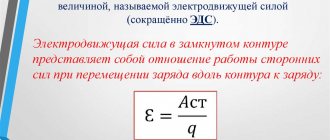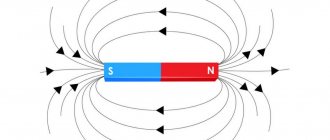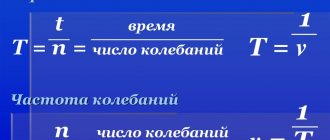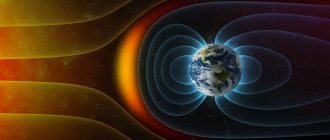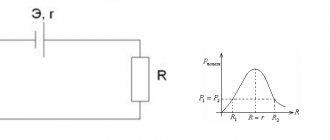Definition and formula of Lorentz force
Definition
The force $\bar{F}$ acting on a moving charged particle in a magnetic field is equal to:
$$\bar{F}=q[\bar{v} \times \bar{B}](1)$$
called Lorentz force (magnetic force)
.
Based on definition (1), the modulus of the force under consideration is:
$$F=qv B \sin \alpha(2)$$
where $\bar{v}$ is the particle velocity vector, q is the particle charge, $\bar{B}$ is the vector of magnetic field induction at the point where the charge is located, $\alpha$ is the angle between the vectors $\bar{v}$ and $\bar{B}$. From expression (2) it follows that if the charge moves parallel to the magnetic field lines, then the Lorentz force is zero. Sometimes, trying to isolate the Lorentz force, they denote it using the index: $\bar{F}_L$
Definition and formula
Hendrik Lorenz proved that electromagnetic induction interacts with charged particles. These interactions give rise to the Lorentz force. The force in question arises under the influence of magnetic induction. It is perpendicular to the velocity vector of the moving particle (see Fig. 1). A necessary condition for the occurrence of this force is the movement of an electric charge.
Rice. 1. Lorenz's conclusions
Pay attention to the location of the vectors (picture on the left, top). Vectors indicating the directions of velocity and Lorentz force lie in the same XOY plane, and they are located at an angle of 90º. The magnetic induction vector is oriented along the Z axis, perpendicular to the XOY plane, which means that in the selected coordinate system it is perpendicular to the force and velocity vectors.
According to Ampere's law:
Considering that
(here j is the current density, q is the unit charge, n is the number of charges per infinitesimal unit length of the conductor, S is the cross-section of the conductor, the symbol v denotes the modulus of the velocity of the moving particle), we write Ampere’s formula in the form:
Since nSdl is the total number of charges in the volume of the conductor, to find the force acting on a point charge, we divide the expression by the number of particles:
Modulus F is calculated by the formula:
From the formula it follows:
- The Lorentz force reaches its maximum value if the angle α is right.
- If a point charge, for example, an electron, enters a medium of a uniform magnetic field, having a certain initial velocity perpendicular to the lines of electromagnetic induction, then the vector F will be perpendicular to the velocity vector. A point charge will be subject to centrifugal force, which will cause it to rotate in a circle. In this case, the work is equal to zero (see Fig. 2).
- If the angle between the induction vector and the particle speed is not 90º, then the charge will move in a spiral. The direction of rotation depends on the polarity of the charge (Fig. 3).
Rice. 2. Charged particle between the poles of magnets
Rice.
3. Orientation of the vector depending on the polarity of the charge From Figure 3 it can be seen that the vector F is directed in the opposite direction if the sign of the charge changes to the opposite (provided that the directions of the other vectors remain unchanged).
The trajectory of a particle is correctly called a helix. The radius of this helix (cyclotron radius) is determined by the compound initial velocity of the particle perpendicular to the field. The pitch of the helix along which the particle moves is determined by the composite initial velocity of the charge entering a uniform magnetic field. This component is directed parallel to the electromagnetic lines.
What is it measured in?
The dimension of the Lorentz force in the international SI system is newton (N). Of course, the modulus of the Lorentz force is such a tiny value compared to Newton that it is written in the form K×10-n N , where 0<K<1, and n is the order of the number 10.
When does it occur?
Magnetic fields do not react to a stationary electric charge, just as the Ampere force does not act on a de-energized conductor.
For the Lorentz force to arise, three conditions must be met:
- The particle must have a negative or positive charge.
- The charged particle must be in a magnetic field.
- The particle must be in motion, that is, the vector v ≠ 0.
If at least one of the conditions is not met, the Lorentz force does not arise.
Lorentz force direction
The Lorentz force (like any force) is a vector. Its direction is perpendicular to the velocity vector $\bar{v}$ and the vector $\bar{B}$ (that is, perpendicular to the plane in which the velocity and magnetic induction vectors are located) and is determined by the rule of the right gimlet (right screw) Fig. 1 (a ). If we are dealing with a negative charge, the direction of the Lorentz force is opposite to the result of the vector product (Fig. 1(b)).
the vector $\bar{B}$ is directed perpendicular to the plane of the drawings towards us.
Determining the direction of the Lorentz force using the left-hand rule
Since in the world of macro objects the Lorentz force manifests itself as the Ampere force, you can use the left-hand rule to determine its direction.
You need to place your left hand so that the open palm is perpendicular and towards the lines of the magnetic field, four fingers should be extended in the direction of the current strength, then the Lorentz force will be directed where the thumb, which should be bent, points.
Consequences of the properties of the Lorentz force
Since the Lorentz force is always directed perpendicular to the direction of the charge velocity, its work on the particle is zero. It turns out that acting on a charged particle with a constant magnetic field cannot change its energy.
If the magnetic field is uniform and directed perpendicular to the speed of motion of the charged particle, then the charge, under the influence of the Lorentz force, will move along a circle of radius R=const in a plane that is perpendicular to the magnetic induction vector. In this case, the radius of the circle is equal to:
$$R=\frac{m \gamma v}{|q| B}(3)$$
where m is the particle mass, |q| is the particle charge modulus, $\gamma=\frac{1}{\sqrt{1-\frac{v^{2}}{c^{2}}}}$ is relativistic Lorentz multiplier, c – speed of light in vacuum.
The Lorentz force is a centripetal force. Based on the direction of deflection of an elementary charged particle in a magnetic field, a conclusion is drawn about its sign (Fig. 2).
Lorentz force. Movement of charges in a magnetic field
Electric charges moving in a certain direction create a magnetic field around themselves, the speed of propagation of which in a vacuum is equal to the speed of light, and in other media is slightly less. If the movement of a charge occurs in an external magnetic field, then an interaction occurs between the external magnetic field and the magnetic field of the charge. Since electric current is the directed movement of charged particles, the force that will act in a magnetic field on a current-carrying conductor will be the result of individual (elementary) forces, each of which is applied to an elementary charge carrier.
The processes of interaction between an external magnetic field and moving charges were studied by G. Lorentz, who, as a result of many of his experiments, derived a formula for calculating the force acting on a moving charged particle from the magnetic field. That is why the force that acts on a charge moving in a magnetic field is called the Lorentz force.
The force acting on the conductor by the drain (from Ampere's law) will be equal to:
By definition, the current strength is equal to I = qn (q is the charge, n is the number of charges passing through the cross section of the conductor in 1 s). This implies:
Where: n0 is the number of charges contained in a unit volume, V is their speed of movement, S is the cross-sectional area of the conductor. Then:
Substituting this expression into Ampere's formula, we get:
This force will act on all charges located in the volume of the conductor: V = Sl. The number of charges present in a given volume will be equal to:
Then the expression for the Lorentz force will look like:
From this we can conclude that the Lorentz force acting on a charge q, which moves in a magnetic field, is proportional to the charge, the magnetic induction of the external field, the speed of its movement and the sine of the angle between V and B, that is:
The direction of movement of charged particles is taken to be the direction of movement of positive charges. Therefore, the direction of a given force can be determined using the left-hand rule.
The force acting on negative charges will be directed in the opposite direction.
The Lorentz force is always directed perpendicular to the speed V of the charge and therefore does not do any work. It only changes the direction of V, and the kinetic energy and velocity of the charge as it moves in a magnetic field remain unchanged.
When a charged particle moves simultaneously in magnetic and electric fields, it will be acted upon by a force:
Where E is the electric field strength.
Let's look at a small example:
An electron that has passed through an accelerating potential difference of 3.52∙103 V enters a uniform magnetic field perpendicular to the induction lines. Trajectory radius r = 2 cm, field induction 0.01 T. Determine the specific charge of the electron.
Solution:
Specific charge is a value equal to the ratio of charge to mass, that is, e/m.
In a magnetic field with induction B, a charge moving at speed V perpendicular to the induction lines is subject to the Lorentz force FL = BeV. Under its influence, the charged particle will move along a circular arc. Since in this case the Lorentz force will cause centripetal acceleration, then according to Newton’s 2nd law we can write:
The electron acquires kinetic energy, which will be equal to mV2/2, due to the work A of the electric field forces (A = eU), substituting into the equation we get:
Having transformed these relations and excluding speed from them, we obtain a formula for determining the specific charge of an electron:
Substituting the original data expressed in SI, we get:
Checking the size:
And for those interested, a video about the movement of charged particles:
Related materials:
- Current strength. Electromotive force. Potential difference
- Basic laws for electric charges
- Field of a magnetized substance. Microscopic…
- How a Microstepping Controller Provides Smoother...
- USB Type C forced the EU to start moving towards a single...
Formula for the Lorentz force in the presence of magnetic and electric fields
If a charged particle moves in space in which there are two fields (magnetic and electric) simultaneously, then the force that acts on it is equal to:
$$\bar{F}=q \bar{E}+q[\bar{v} \times \bar{B}](4)$$
where $\bar{E}$ is the electric field strength vector at the point where the charge is located. Expression (4) was empirically obtained by Lorentz. The force $\bar{F}$, which is included in formula (4) is also called the Lorentz force (Lorentz force). Division of the Lorentz force into components: electric $(\bar{F} = q \bar{E})$ and magnetic $(\bar{F}=q[\bar{v} \times \bar{B}])$ relatively, since it is related to the choice of the inertial frame of reference. Thus, if the reference frame moves with the same speed $\bar{v}$ as the charge, then in such a frame the Lorentz force acting on the particle will be zero.
Lorentz force acting on an electron
In a particular case, the charge carrier is an electron.
Then in formula (5) as Q one should substitute \[ e = - 1.602 \cdot 10^{-19} \enspace Cl. \]
When determining the direction of electron movement using the left-hand rule, it should be taken into account that the direction of electron movement is opposite to the technical direction of the current.
Lorentz force acting on electron and proton
The magnitude and direction of the Lorentz force are determined by the relation
\[ \vector{F_{L}}= e \vector{v} × \vector{B} \]
where $\vector{v}$, $\vector{B}$ and $\vector{F}$ form a right-handed system.
For electrons moving perpendicular to the magnetic field, the formula simplifies:
\[ F_{L} = ev B \]
Since the force acts perpendicular to the speed and direction of the field, it creates centripetal acceleration, i.e. changes the direction of speed without changing its magnitude. Therefore, the electron moves in a magnetic field in a circle.
Task examples
Problem 1
A charge of 0.005 C, which moves in a magnetic field with an induction of 0.3 T, is subject to the Lorentz force. Calculate it if the speed of the charge is 200 m/s, and it moves at an angle of 450 to the lines of magnetic induction.
| Given: q = 0.005 C B = 0.3 T v = 200 m/s α = 450 | Solution: In the conditions of the problem there is no mention of the electric field, so the Lorentz force can be found using the following formula: FL=qvBsinα=0.005×200×0.3×sin 450 =0.3×22=0.21 N |
Problem 2
Determine the speed of a body that has a charge and which moves in a magnetic field with an induction of 2 T at an angle of 900. The magnitude with which the field acts on the body is 32 N, the charge of the body is 5 × 10-3 C.
| Given: q = 0.005 C B = 2 T FL = 32 N α = 900 | Solution: To find the charge speed, it is necessary to slightly modify the formula for finding the Lorentz force: FL=qvBsinαv=FLqBsinα v=320.005×2×sin900=320.01×1=32000ms=32 km/s |
Problem 3
An electron moves in a uniform magnetic field at an angle of 900 to its field lines. The magnitude with which the field acts on the electron is 5 × 10-13 N. The magnitude of the magnetic induction is 0.05 Tesla. Determine the acceleration of the electron.
| Given: q = -1.6 × 10-19 C B = 0.05 T FL = 5 × 10-13 N α = 900 | Solution: In this problem, the Lorentz force also forces the electron to move in a circle. Therefore, here acceleration should be understood as centripetal acceleration: ac=v2R At the moment, neither the speed of the electron nor the radius of the circle along which it moves is known. v=FLqBsinα=5×10-13-1.6×10-19×0.05∙sin900=6×107ms R=mvqB=9×10-31×6×107-1.6×10-19×0.05=6.8×10-3ms |
ac=v2R=6×10726.8×10-3=5×1017ms2
Electrodynamics operates with concepts that are difficult to find an analogy in the ordinary world. But this does not mean at all that they are impossible to comprehend. With the help of various visual experiments and natural phenomena, the process of understanding the world of electricity can become truly exciting.
Problems on the topic “Lorentz force”
Even if you are not a beginner, before solving problems, read the general instructions and keep useful formulas on hand just in case.
Lorentz force problem No. 1
Condition
An electron with an energy of 300 eV moves perpendicular to the induction lines of a uniform magnetic field with a strength of 465 A/m. Determine the Lorentz force, speed and radius of the electron trajectory.
Solution
The electron speed can be found from the kinetic energy formula:
E k = m v 2 2 v = 2 E k m
The Lorentz force is a centripetal force, which means that according to Newton’s second law, we can write:
Magnetic induction is equal to the intensity multiplied by the magnetic constant. Substituting the previously found expression for speed into the formula for radius and Lorentz force, we write:
R = m 2 E kt q μ 0 H = 2 E kt q μ 0 HF l = q 2 E kt μ 0 H
Now all that remains is to substitute the values and calculate:
v = 2 4, 8 10 - 16 9, 1 10 - 31 = 3, 25 10 7 m s F l = 4 3, 14 10 - 7 465 1, 6 10 - 19 3, 25 10 7 = 3 10 - 15 N R = 2 4, 8 10 - 16 9, 1 10 - 31 4 3, 14 10 - 7 465 1, 6 10 - 19 = 0.32 m
Answer: v = 3.25 · 10 7 m s; F l = 3 10 - 15 N; R = 0.32 m .
Lorentz force problem No. 2
Condition
An alpha particle flies into a magnetic field with an induction of 1 Tesla perpendicular to the field lines. Find the angular momentum of the particle relative to the center of the circle along which it will move.
Solution
When a particle flies into the field perpendicular to the lines of force, the Lorentz force begins to act on it, which acts as a centripetal force. The radius of the circle along which the particle will move:
R = mv QB m = 6.65 10 - 27 kg - mass of alpha particles Q = 2 e = 3.2 10 - 19 K l - z a r i d a l f a c h a s t i c s
We find the angular momentum of the particle relative to the center of the circle using the formula:
L = mv R = m 2 v 2 QB = 6, 65 10 - 27 2 0, 35 10 7 2 3, 2 10 - 19 1 = 5, 42 10 - 21 kg m 2 s
Answer: 5, 42 10 - 21 k g m 2 s .
Lorentz force problem No. 3
Condition
In a uniform magnetic field with induction B = 0.5 T, a rod of length l = 20 cm rotates with a frequency n = 10 s-1. The axis of rotation is parallel to the induction lines and passes through one of the ends of the rod perpendicular to its axis. Determine the potential difference U at the ends of the rod.
Solution
Let us consider the physical essence of the processes taking place in the rod. When a rod moves in a magnetic field, an induced emf arises in it, which is caused by the action of the Lorentz force on the charges of the rod.
Under the influence of this force, a separation of charges occurs in the rod: free electrons move upward and a potential difference arises between the ends of the rod.
The charges at the ends of the rod create a field E, which prevents further separation of charges. At some point, the Lorentz force will be balanced with the force of the emerging field:
F l = e E E = F l e = ev B e = v B
The speed of the lower end of the rod, and therefore the speed of the electrons in it, can be found by knowing the rotation frequency and the length of the rod:
v = 2 π n l
Taking this into account, the expressions for the electric field strength will be rewritten:
E = 2 π nl B
The induced potential difference, by definition, is equal to:
U = E l U = 2 π nl 2 B = 2 3.14 10 - 1 0.2 2 0.5 = 1.3 V
Answer: 1.3 V.
Lorentz force problem No. 4
Condition
What force acts on a charge of 0.005 C moving in a magnetic field with an induction of 0.5 T at a speed of 150 m/s at an angle of 45 degrees to the magnetic induction vector?
Solution
This is the simplest problem to determine the Lorentz force. Let us recall the formula and write that the Lorentz force acts on the charge, equal to:
F = q v B sin α
Let's substitute the values and calculate:
F = 0.005 150 0.5 2 2 = 0.26 N
Answer: 0.26 N.
Lorentz force problem No. 5
Condition
A body with a charge of 0.8 mC moving in a magnetic field is acted upon by a force equal to 32 N. What is the speed of the body if the magnetic field vector is perpendicular to it?
Solution
This is a classic problem using the Lorentz force formula. Since the velocity and magnetic induction vectors are perpendicular, we can write:
F = qv B sin α = qv B v = F q B = 32 0, 8 10 - 3 2 = 20 10 3 m s
Answer: 20000 m/s.
Are you undergoing magnetostatics? You may also be interested in:
- Problems on the Biot-Savart-Laplace law.
- Problems on the magnetic field circulation theorem.
